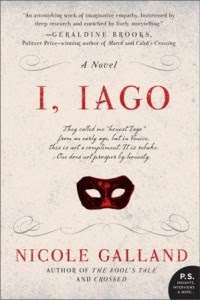Review: I, Iago, by Nicole Galland
 |
| I, Iago by Nicole Galland 370 pgs William Morrow, 2012 |
Just in case you have no idea what I'm talking about, let me break things down very simply for you: Boy meets girl. Boy elopes with girl. Boy's bestie gets jealous and tricks him into thinking the girl is a whore. Boy kills girl. Boy kills self. Definitely a Tragedy.
One of the benefits of writing an adaptation of a play so well-known is surely the fact that so many of those who will actually pick up the book already know the source material and can recognize all of the author's elbowed hints and easter eggs and run with them. But adaptations have their drawbacks as well, especially when the author is attempting to explain the motives of a well-known villain.
In the case of Nicole Galland's I, Iago (William Morrow, 2012) we're meant to understand that Iago was a totem of honesty before he turned his jealousy into Othello's - a second son who, despite his best efforts and honesty, always pulled the short straw. And while this kind of simpering goodness if often annoying, Galland has done her job in making him into a character who deserves the reader's sympathy.
The novel takes us through Iago's pre-Othello life, and then proceeds through the entirety of Shakespeare's play, though this is addressed completely in prose and paraphrase. Relying on the bard to carry what approximates over a third of the book (sectioned off as "after" while all events preceeding are titled "before") is a risk that the author perhaps needn't have taken. The pre-play exploits could have stood alone as a rather good book (much in the way part one in a series might nod toward or hint at its successor without addressing it directly). But handing a diligent reader this book and expecting them to appreciate a modern author's version of the play itself, that's a welcome mat for comparison and criticism and, I'm afraid, more the latter.
Galland's handling of the play proper is sloppy. An apparent need for self-reference to the 211-page expository novel preceding seems insistent. Rather than allowing the reader to have received all of this new infomation and applying it to the play they know, it's shoehorned for them into the prose version of the play, and drawn out in such a way that one cannot help but roll ones eyes. It was a lot like reading the mockbuster version of the play, written and produced by The Asylum, though Ms. Galland is a few centuries late to really benefit from the attempt.

Comments
Post a Comment
Any and all feedback is welcome - thanks for taking the time!